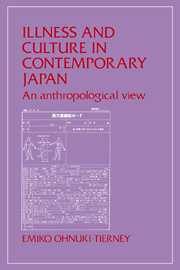Book contents
- Frontmatter
- Contents
- List of illustrations
- Acknowledgments
- 1 Introduction
- Part I Basic concepts and attitudes toward health and illness
- Part II Medical pluralism
- 5 Kanpō: Traditional Japanese medicine of Chinese origin
- 6 Medical roles of Japanese religions: A descriptive overview
- 7 Medical roles of Japanese religions: A historical-symbolic interpretation
- 8 Doctors and outpatients: Biomedicine (I)
- 9 Hospitalization: Biomedicine (II)
- 10 Medical pluralism
- Summary
- References
- Index
5 - Kanpō: Traditional Japanese medicine of Chinese origin
Published online by Cambridge University Press: 12 January 2010
- Frontmatter
- Contents
- List of illustrations
- Acknowledgments
- 1 Introduction
- Part I Basic concepts and attitudes toward health and illness
- Part II Medical pluralism
- 5 Kanpō: Traditional Japanese medicine of Chinese origin
- 6 Medical roles of Japanese religions: A descriptive overview
- 7 Medical roles of Japanese religions: A historical-symbolic interpretation
- 8 Doctors and outpatients: Biomedicine (I)
- 9 Hospitalization: Biomedicine (II)
- 10 Medical pluralism
- Summary
- References
- Index
Summary
Of all the medical systems used in Japan today, only kanpō and biomedicine exist as formal systems, in that they are institutionalized and their practitioners are professionals. In addition, most people recognize only these two as “medical systems.” As the word kanpō (kan = the Han Dynasty in China, pō = the method) indicates, kanpō was introduced to Japan from China, probably by the sixth century. Since its introduction, kanpō has undergone extensive transformation within the Japanese sociocultural milieu. Even in its basic premises, kanpō in contemporary Japan differs significantly from Chinese medicine, both ancient and contemporary (Mori 1977). I will use the term kanpō to refer only to the system as it is practiced in contemporary Japan. The primary treatment methods in this system are plant and animal medicine, acupuncture, and moxibustion (burning small cones of dried mugwort on certain parts of the body) (see Photos 3 and 5).
Although the overall history of kanpō will not be described here, it is significant to note that the system was legally prohibited at two different times (for the history of kanpō, see Ishihara 1978; Leslie 1974; Lock 1980a; Otsuka 1976). In 1868 Japan reopened its doors to the West and began an intense effort to become one of the great world powers. In 1875 the government proclaimed that, in order to practice kanpō, a physician must first pass an examination in seven subjects of Western medicine. This was an attempt to suppress the practice of kanpō and to Westernize medical practice in Japan.
- Type
- Chapter
- Information
- Illness and Culture in Contemporary JapanAn Anthropological View, pp. 91 - 122Publisher: Cambridge University PressPrint publication year: 1984

